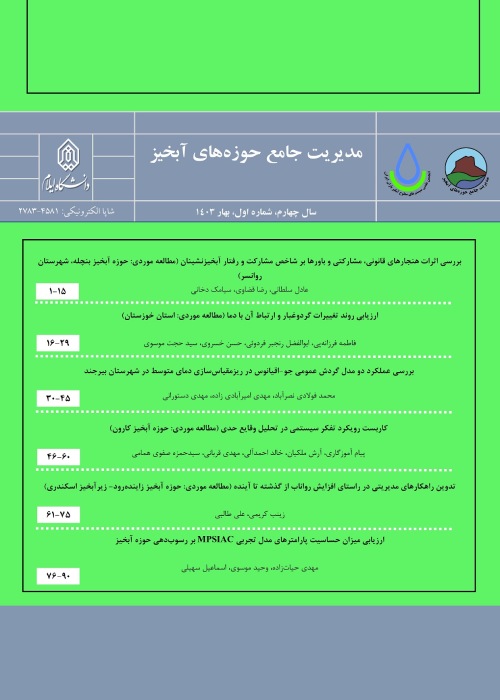Performance Evaluation of Two General Circulation Models for Downscaling Average Temperature in Birjand County
Climate change has a significant impact on water resources and the environment, which is reflected in agriculture, society, and economy. The use of General Circulation Models (GCMs) with downscaling models is a method for assessing climate change. Considering the placement of South Khorasan Province and the city of Birjand in the arid region of Iran, population growth, industrial and mining development, and the pursuit of sustainable agriculture, it is essential to assess the effects of climate change on essential meteorological parameters. The objective of this study is to compare the performance of historical models NCEP and ECMWF in downscaling temperature parameters for the Birjand County and investigate the changes in this parameter until 2030 using the top model and the SSP245 scenario with the CanESM5 model.
In this research, to compare the performance of two GCMs, NCEP and ECMWF, in downscaling temperature parameters, daily temperature data from the Birjand synoptic station for the period from 1990 to 2021 were used as the baseline period. Additionally, to evaluate the performance of these two GCMs, the statistical downscaling model SDSM was utilized. To assess the performance of these two models, evaluation criteria such as NS, KGE, RMSE, and BR2 were employed.
To investigate and compare the performance of two GCMs, NCEP and ECMWF, daily average temperature data from the Birjand synoptic station were used from the January 1990 to the September 2021. The data from 1990 to the January 2008 were considered for calibration, and data from the January 2008 to the September 2015 were used for validation. Both NCEP and ECMWF models had 26 parameters, and for downscaling, the parameters with the highest correlation with observed temperature were selected among these 26 parameters using the R software and the HydroGof package. Additionally, evaluation criteria such as NS, RMSE, KGE, and BR2 were used to assess the models' performance in calibration and validation sections. The closeness of variance and mean values of time series generated by the NCEP and ECMWF models to the variance and mean values of observed time series in the entire simulation period was examined using F and T tests. The results of the calibration section showed that the two models, NCEP and ECMWF, exhibited similar performance since the values of evaluation criteria NS, RMSE, KGE, and BR2 for the ECMWF model were calculated as 0.69, 4.86, 0.85, and 0.7, respectively, and for the NCEP model, they were 0.70, 4.79, 0.85, and 0.7, respectively. Since box plots, mean values, and standard deviations have a high capability in deciding the degree of dispersion and similarity between two time series, box plots, mean values, and standard deviations of the generated time series and observed time series in the calibration and validation periods were used to assess the similarity and closeness of the time series. The results of the evaluation criteria in the validation section showed that the ECMWF model outperformed the NCEP model, with values of evaluation criteria NS, RMSE, KGE, and BR2 for the ECMWF model being calculated as 0.69, 4.9, 0.85, and 0.73, respectively, and for the NCEP model, 0.67, 5.3, 0.83, and 0.7, respectively. Overall, the results indicated that the ECMWF model had a better performance and was selected as the superior model. Therefore, to simulate and predict the average temperature parameter, the parameters mslp, P500, P5-f, P5-u, P850, and P8-u from the ECMWF model were used. Consequently, it is predicted that the average temperature will increase by approximately 3 degrees Celsius compared to the statistical baseline period in the next 8 years.
The results indicate that based on the evaluation criteria, the ECMWF model performs relatively better in estimating the average temperature of Birjand County compared to the NCEP model. Moreover, the analysis of box plots, mean values, and standard deviations of the generated time series in the calibration and validation sections showed that both models produced similar patterns of dispersion, minimum, maximum, and mean values compared to the observed time series. However, the ECMWF model exhibited relatively better performance in terms of mean and variance values of the generated data on a monthly basis in the calibration and validation periods. As a result, the ECMWF model was selected as the superior model for simulating and predicting the average temperature of Birjand County for the years 2022 to 2030 under the SSP245 emission scenario using the CanESM5 model. The predicted results indicate that the average temperature of Birjand County is expected to increase by approximately 3 degrees Celsius compared to the statistical baseline period.
- حق عضویت دریافتی صرف حمایت از نشریات عضو و نگهداری، تکمیل و توسعه مگیران میشود.
- پرداخت حق اشتراک و دانلود مقالات اجازه بازنشر آن در سایر رسانههای چاپی و دیجیتال را به کاربر نمیدهد.



